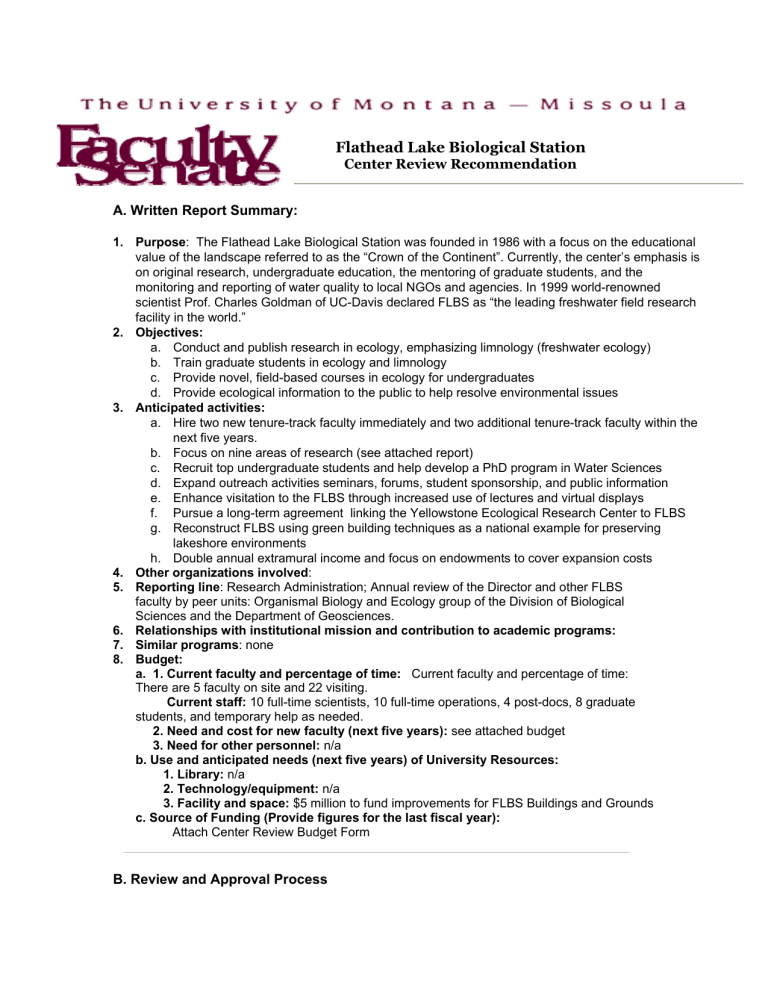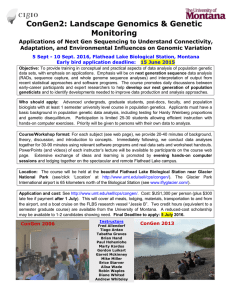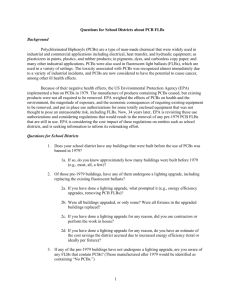Flathead Lake Biological Station Center Review Recommendation A. Written Report Summary:

Flathead Lake Biological Station
Center Review Recommendation
A. Written Report Summary:
1. Purpose : The Flathead Lake Biological Station was founded in 1986 with a focus on the educational value of the landscape referred to as the “Crown of the Continent”. Currently, the center’s emphasis is on original research, undergraduate education, the mentoring of graduate students, and the monitoring and reporting of water quality to local NGOs and agencies. In 1999 world-renowned scientist Prof. Charles Goldman of UC-Davis declared FLBS as “the leading freshwater field research facility in the world.”
2. Objectives: a. Conduct and publish research in ecology, emphasizing limnology (freshwater ecology) b. Train graduate students in ecology and limnology c. Provide novel, field-based courses in ecology for undergraduates d. Provide ecological information to the public to help resolve environmental issues
3. Anticipated activities: a. Hire two new tenure-track faculty immediately and two additional tenure-track faculty within the next five years. b. Focus on nine areas of research (see attached report) c. Recruit top undergraduate students and help develop a PhD program in Water Sciences d. Expand outreach activities seminars, forums, student sponsorship, and public information e. Enhance visitation to the FLBS through increased use of lectures and virtual displays f. Pursue a long-term agreement linking the Yellowstone Ecological Research Center to FLBS g. Reconstruct FLBS using green building techniques as a national example for preserving lakeshore environments h. Double annual extramural income and focus on endowments to cover expansion costs
4. Other organizations involved :
5. Reporting : Research Administration; Annual review of the Director and other FLBS faculty by peer units: Organismal Biology and Ecology group of the Division of Biological
Sciences and the Department of Geosciences.
6. Relationships with institutional mission and contribution to academic programs:
7. Similar : none
8. Budget: a. 1. Current faculty and percentage of time: Current faculty and percentage of time:
There are 5 faculty on site and 22 visiting.
Current staff: 10 full-time scientists, 10 full-time operations, 4 post-docs, 8 graduate students, and temporary help as needed.
2. Need and cost for new faculty (next five years): see attached budget
3. Need for other personnel: n/a b.
Use and anticipated needs (next five years) of University Resources:
1. Library: n/a
2. Technology/equipment: n/a
3. Facility and space: $5 million to fund improvements for FLBS Buildings and Grounds c.
Source of Funding (Provide figures for the last fiscal year):
Attach Center Review Budget Form
B. Review and Approval Process
2.
The Faculty Senate through its Chair, who in turn shall distribute it to ECOS and other committees, and approve or disapprove the proposal by a vote of the Senate.
Review in terms of Scope as stated in academic policy 100.0
To provide instruction, scholarship, or service to the University, state or world by: (1) focusing attention on an area of strength and/or addressing a critical issue, or (2) facilitating collaborative, multi-disciplinary endeavors to combine resources from several programs or institutions to address issues of common interest.
Review in terms of the University’s mission.
Comments: FLBS appears to be well funded, and its 30 year history of self-support argues that this will continue to be the case.
Does ECOS/Faculty Senate consider this center controversial? No
Is the relationship with academic units beneficial? Yes
Is the program revenue neutral or does it consume more resources than it generates? If so, is the use of University resources justified? The program is revenue neutral.
Is the entity making progress toward objectives? Yes







